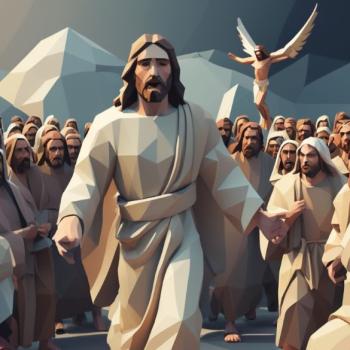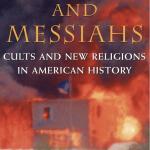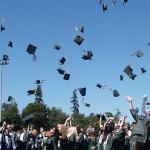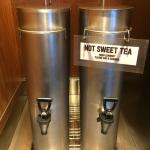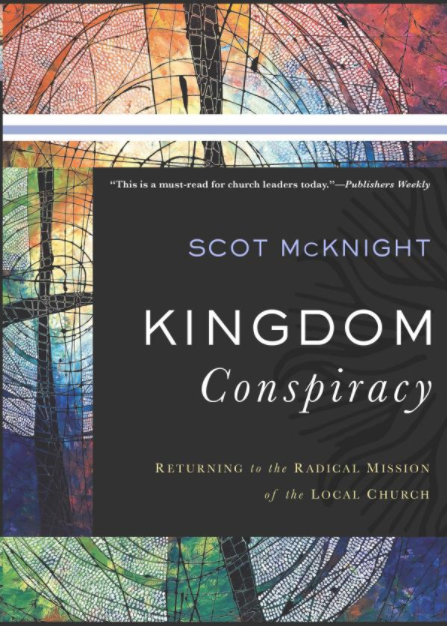 Food deserts and the Walk for Food, with Whitney Pipkin:
Food deserts and the Walk for Food, with Whitney Pipkin:
Two miles isn’t too far to march for a worthy cause, as people are prone to do in the nation’s capital. But it is a long way to walk for groceries.
That’s the impression organizers of a recent Grocery Walk in Washington, D.C.’s Anacostia neighborhood wanted to invoke when they gathered nearly 500 people to walk that far — wielding carrots and “food justice” signs — in the latest effort to address the intractable problem of food deserts. More than half of the participants were residents who live in or near the District’s Ward 8, where a Giant Foods store is the only full-service grocer serving 70,000 residents, leaving fresh, affordable foods out of reach for many.
Nearly 40 million Americans live in communities with these so-called grocery gaps, where it is easier for people to buy grape soda than a handful of grapes, according to the U.S. Department of Agriculture.
Lauren Shweder Biel, executive director of the nonprofit DC Greens, which organized the event, says having so many residents involved demonstrates how strong the demand is for the healthful produce. She says she hopes that city officials — some of whom participated in the walk — retailers and the rest of the country would take notice.
“I think one of the most powerful impacts of an action like the Grocery Walk is that it silences the myth that poor people don’t want healthy food,” says Shweder Biel.
That perception keeps many food retailers from locating to low-income neighborhoods, says Christopher Walker, senior campaign director for the American Heart Association in Austin, Texas. There, food access advocates hosted a similar — but much smaller — stroll in 2015 through an underserved community near Austin’s airport. They wanted to illustrate how difficult it can be to cross basic items off a shopping list — let alone make a nutritious meal — by trekking to the handful of corner stores that constitute the only retail options within walking distance.
“I don’t think people realize how important it is to have a grocery store until they don’t have one,” says Walker. “We talk about grocery stores as if they’re a luxury, but that’s not the way we live our lives. Other than work, we go to the grocery store more than any other place — and we have entire neighborhoods and communities that don’t have that.”
This story is now starting to look fishy.
Key elements of the women’s account are contradicted by authorities, and are not consistent with weather reports or basic geography of the Pacific Ocean. The discrepancies raised questions about whether Appel and her sailing companion, Tasha Fuiava, could have avoided disaster.
On their first day at sea, the two women described running into a fierce storm that tossed their vessel with 60 mph (97 kph) winds and 30-foot (9-meter) seas for three days, but meteorologists say there was no severe weather anywhere along their route during that time.
After leaving “we got into a Force 11 storm, and it lasted for two nights and three days,” Appel has said of the storm they encountered off Oahu. In one of the first signs of trouble, she said she lost her cellphone overboard.
“We were empowered to know that we could withstand the forces of nature,” Appel said. “The boat could withstand the forces of nature.”
But the National Weather Service in Honolulu said no organized storm systems were in or near Hawaii on May 3 or in the days afterward. Archived NASA satellite images confirm there were no tropical storms around Hawaii that day. Appel expressed surprise that there was no record of the storm. She said they received a Coast Guard storm warning while sailing after sunset on May 3.
This story is already looking selfish.
PHILADELPHIA — Embattled 76ers center Jahlil Okafor admitted that his time with the team is likely over, saying he’s fine with them not picking up the fourth-year option of his deal and that he has requested a buyout or trade from the team.
“Honestly, I did not want them to pick up my option,” Okafor said at the team’s shootaround Wednesday. “This is my life. This is my career, and I’m not getting an opportunity here, which is fine. The team looks great and I’m not a part of that. I want the team to do great things, but at the same time I want to play.”
Okafor had fallen out of the team’s rotation this season, appearing in just one game against Toronto in which he played 22 minutes and finished with 10 points and nine rebounds.
A buyout would allow Okafor to test the market, potentially sign a short-term contract, and then set himself up for free agency in 2018, but Okafor says that team president Bryan Colangelo has so far been resisting his request for a buyout, despite failing to find a trade for him.
“I’ve asked for a buyout,” he said. “I had a talk with Bryan about that yesterday, just because I want to play. I know that’s not being here. I know a buyout is one of the options where I get an opportunity to play elsewhere and to get on the court. But Bryan didn’t think that would be a good idea because he said then they would be giving me away to a team for free, but that’s pretty much where we stand right now.”
He added that he would like a resolution to his situation as soon as possible.
“A buyout or a trade,” Okafor said. “A buyout’s not the only option. It’s just, I want to get on the court. That’s not happening here. It could be a buyout, it could be a trade. I just want something to happen rather quickly.”
Dear Gene, using stereotypes of non-Lutherans doesn’t make it easier to describe Lutherans accurately. Your hero said Was Christum treibet, stick with that.
Speaking of the Reformation, there’s some serious Protestant-cum-Pentecostalism vs. Catholicism at work in South America, and Sarah Pulliam Bailey has the pulse of at least one arm:
Speaking from a stage encircled by 12 large wooden crosses, Gabriel Camargo held up wads of fake Brazilian money, showing his flock what could be theirs.
“God will bless you if you give a lot more to the church,” said Camargo, a Pentecostal pastor with the Universal Church of the Kingdom of God.
Then he extended an arm and pointed a black pouch toward his parishioners in the working-class neighborhood of Osasco.
Pick up your wallets and purses, he said, instructing his flock to look for Brazilian reais. About a dozen people hurried forward to dump bills and coins into the bag.
Those without cash didn’t have to worry: An usher held out a credit card machine. “You’ll have so much money” after giving generously to the church, the pastor boomed, that “smoke is going to come out of the machine.”
In a country struggling with the worst economic crisis in its history, with long lines at unemployment offices and public health clinics, perhaps it’s not surprising that Brazilians are increasingly drawn to the promises of personal wealth.
The belief that faith can lead to riches — known as the prosperity gospel — is a form of Pentecostalism, a Protestant movement that, in a modern-day version of the Protestant Reformation 500 years ago, is challenging the dominance of the Catholic Church in Latin America’s most populous country.
The Neanderthals never had a chance, AP News:
NEW YORK (AP) — What killed off the Neanderthals? It’s a big debate, and now a study says that no matter what the answer, they were doomed anyway.
Our close evolutionary cousins enjoyed a long run in Europe and Asia, but they disappeared about 40,000 years ago after modern humans showed up from Africa.
The search for an explanation has produced many theories including climate change, epidemics, or inability to compete with the modern humans, who may have had some mental or cultural edge.
The new study isn’t intended to argue against those factors, but just to show that they’re not needed to explain the extinction, says Oren Kolodny of Stanford University.
He and colleague Marcus Feldman present their approach in a paper released Tuesday by the journal Nature Communications.
They based their conclusion on a computer simulation that represented small bands of Neanderthals and modern humans in Europe and Asia. These local populations were randomly chosen to go extinct, and then be replaced by another randomly chosen population, with no regard for whether it represented the same species.
Neither species was assumed to have any inherent advantage, but there was one crucial difference: Unlike the Neanderthals, the modern humans were supplemented by reinforcements coming in from Africa. It wasn’t a huge wave, but rather “a tiny, tiny trickle of small bands,” Kolodny said.
Still, that was enough to tip the balance against the Neanderthals. They generally went extinct when the simulation was run more than a million times under a variety of assumptions.
If survival was a game of chance, “it was rigged by the fact that there’s recurring migration,” Kolodny said. “The game was doomed to end with the Neanderthals losing.”
Kolodny said the evidence that such migrations actually occurred is suggestive rather than conclusive. Such migrations would not be expected to leave much of an archaeological trace, he said.
Experts in human origins said the paper could help scientists pin down the various factors that led to the Neanderthals’ demise. It fits in with other recent attempts to explain the extinction without assuming behavioral differences between Neanderthals and our ancestors, said Wil Roebroeks of the University of Leiden in the Netherlands. The notion of such differences is largely disproven, he said.
Katerina Harvati of the University of Tuebingen in Germany said while the new work could be useful in solving the extinction mystery, it doesn’t address the question of why modern humans dispersed from Africa into Europe and Asia. It’s important to figure out what was behind that, she said in an email.
Gleaning today, by Jonathan Bloom:
Tilahun Liben thought he was seeing things. Surely that mound of orange orbs under those trees near his church couldn’t be oranges. Could they?
It was 2010, and Liben had just arrived in Tucson, Ariz., as a refugee from Ethiopia. He had been a musician, playing saxophone in nightclubs, but that life ended abruptly in 1999 when an oppressive regime imprisoned him for three months for his political dissent. After Liben’s release, further persecution forced him to flee his homeland: He ended up at the Kakuma refugee camp, in Kenya, where he waited 10 years to be resettled.
Liben, 46, hadn’t been in the city more than a few months when he met Barbara Eiswerth, an American who had, by chance, visited Kakuma during Liben’s stay. Here in Tucson, Liben learned, Eiswerth had founded an organization called Iskashitaa Refugee Network that helps refugees find community and purpose through gleaning backyard fruit, which they eat themselves and share with other Arizonans in need.
Gleaning — or harvesting unwanted fruit — was a new concept to Liben. Then again, so was the sight of oranges and grapefruit piling up beneath trees. “In Ethiopia, the owner of the tree will get the fruit to the market,” Liben says. “And when there was fruit on the ground, people would pick it up and use it. There’s no waste.” Within days, Liben was knocking on Iskashitaa’s door.
Eiswerth started Iskashitaa in 2003, after she mapped Tucson’s public fruit as part of her doctoral program in geology — a project that revealed to her the area’s edible inventory. Not wanting that bounty to go to waste, she and her colleagues had distributed it at several “free farmer’s markets.” One of these events specifically targeted refugee children, whose enthusiasm for the gleaned fruit blew Eiswerth away.
“I thought, wow, the need is here in this refugee community,”she says. “Why not teach them about local food resources while teaching them to fit in?”
The produce makes a difference to Tucson’s refugees, who despite having an organizational sponsor, often live in poverty. In nearly two decades of working with refugees, Eiswerth, 55, has seen the depth of their talents and skills, but also their hardships. “I’ve gone into refugee homes and opened a fridge to see a gallon of milk, a few bottles of water and a few fruits,” she says.




